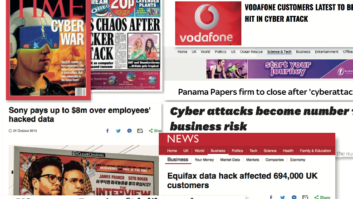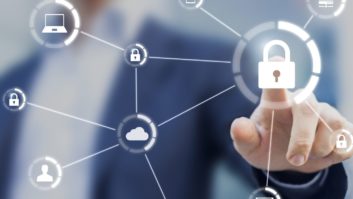
AV installations increasingly have a networked element; but while the IT world has long experience of dealing with security issues, it’s relatively new ground for our industry. Steve Montgomery begins by outlining the three types of attack that networked AV systems can suffer.
In an age of heightened security controls and awareness, and with cyberattacks occurring on a daily basis, the need to maintain security of all data and communications networks is stronger than it has ever been. More equipment and devices are now connected to a network than ever before, providing an enormous level of opportunity for unauthorised access.
This affects the AV industry. AV content distribution is rapidly moving to a network-centric model, with IP-based networking now the predominant method of audio distribution and video over IP becoming far more common. Nearly every piece of modern technology has an internet or wireless connection capability, whether it needs it to function or simply as an aid to control and installation.
“AV integrators need to be wary of any equipment that is connected to the internet and be aware of security protocols within the equipment provided by the manufacturer,” points out Chuck Espinoza, staff instructor for InfoComm International. “Equipment that requires internet access for essential operation like RSS feeds or to enhance its operation such as service updates, automation or other functions, is a risk to any system and knowing how to mitigate cyber-risks now has to be part of AV integrators’ expertise.”
Areas of concern
There are three primary areas of concern of which AV integrators need to be aware of in network-connected AV installations: cyberattacks on an IT network through connected AV devices, attacks on AV system components originating from the wider network, and general hacking of wireless or internet signals.
Despite the ubiquity of AV-IT convergence, in practice these are still two individual technologies linked together in a basic fashion. “The IT community has tackled and largely countered the risk of cyberattacks on IT networks through firewalls, access procedures and limitations and other security measures,” explains Roland Hemming, founder of RH Consulting. “But when it comes to the AV system connected to their IT network, they do not place such stringent restraints on deployed devices. Networked AV appliances are regularly connected to the in-house IT network for convenience in setting them up and managing their operation, but security has to extend beyond basic firewall procedures. Many IT professionals don’t even know that a lot of AV equipment has additional network connectivity such as local WiFi, or can be configured with mobile devices that have their own external data connection.”
Separation of an AV network from the IT network is one solution, as Ronald Prague, Biamp Systems’ senior network architect, explains: “When planning an AV network, best practices are to separate your AV and control traffic from other networks, logically or physically, and make sure only those users and services that need access, actually have it. This separation is usually for performance reasons, keeping AV traffic unimpacted by other network traffic, but it does offer an added layer of security by virtue of being unreachable from non-AV networks and users.”
The banking and financial sector is, of necessity, acutely aware of the need for security across all systems. “Visitors and staff expect to be able to connect to the network to share information and make presentations at meetings using their own devices and the corporate AV facilities, but this leads to security issues,” points out David Ravenhill, media engineering manager at Credit Suisse. “We can set up wireless networks fairly easily but must ensure that users cannot access other people’s devices in other areas through it. The use of locked-down wireless networks is essential and one that we are pushing service providers to deliver.”







